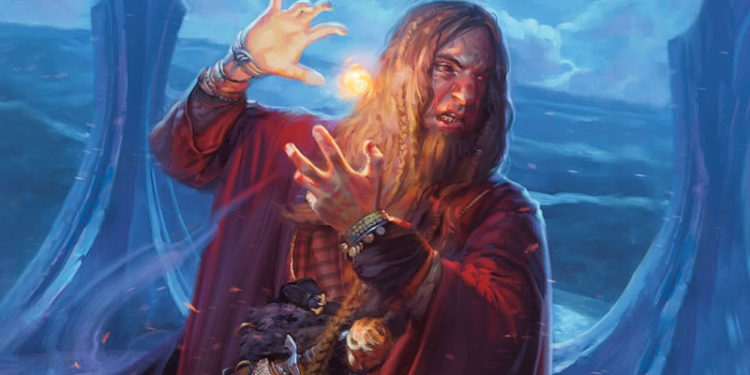Unearthed Arcana: Sorcerer Breakdown

After a few weeks off, Unearthed Arcana returns with four new sorcerous origins, one of which is a rework of material released in one of the earliest UAs. The sorcerer is a challenging class to create subclasses for, in my view, because the core of what the sorcerer can do is “like a wizard, but narrower.” Thematically and mechanically, it’s probably more about “do one thing and do it well” than any other class. I mean, you can play a sorcerer for utility or buff/debuff spells, but mostly the class wants you to blast things to hell. Let’s see what they do to shake that up.
Favored Soul
This is the rework – not too long after the core books came out, they released a Favored Soul subclass. If you’re not familiar, the Favored Soul first showed up in 3.x as a base class, offering sorcerer-like spontaneous casting for the divine-magic set. Thematically, nothing has really changed, though one of the signature features of previous iterations is gone. I’ll get to that in a moment.
- Divine Magic means you treat the cleric spell list as an equal set of options.
- We also have Unearthed Arcana: The Faithful to look back to for other shots at this general “arcane/divine hybrid” concept.
- Supernatural Resilience is an extra hit point per level, plain and simple. We’ll call it “the front half of Draconic Resilience.”
- This lays down the recurring concept of this subclass and every other subclass in this document: “How can we grant the sorcerer added survivability?”
- To quote my inestimable colleague Colin: “Favored of the Gods, a.k.a. Hella Bless.” Add 2d4 to a failed saving throw or missed attack roll, 1/short rest.
- Blessed Countenance makes your appearance more idealized in one of four ways (this is a ribbon), and grants double proficiency bonus to Charisma checks whenever your proficiency bonus applies.
- Divine Purity is a trifecta of immunities, so you know I’m going to hate it with a burning hatred. Disease, poison, poisoned. Really, y’all?
- Unearthly Recovery is like Wholeness of Body, but better and with some mostly pointless limitations on when you can use it. (Is anyone really going to use this when they’re not at or below bloodied?) It restores hit points equal to half your maximum, 1/long rest.
- This feature bothers me unreasonably – I recall the 3.x and 5e Favored Soul, and I know that they’re supposed to get wings at their top end. Like the Draconic sorcerer’s Dragon Wings, but feathery.
No joke, five of the six features boost survivability (since no spellcasting list is better for survival than the cleric). This could certainly be a party’s main healer; I’d say to plan on cure wounds, lesser restoration, heal, and revivify or raise dead, and past that everything else can safely be from the normal sorcerer list. If you’re feeling generous, add bless, which is nearly always the best way to spend your Concentration. I don’t think there’s all that much interesting stuff going on here; Blessed Countenance is about the only feature that communicates a theme other than “the gods want you alive rather than dead.” It’s about its playstyle rather than telling a nuanced story. It’s fine.
Phoenix Sorcery
As a long-term fan of Steven Brust, I am predisposed to like Phoenix Sorcery, even though it’s almost definitely not a secret magic practiced by Zerika IV. On the plus side, it’s also not the Phoenix Force (which should be a warlock patron rather than a sorcerous origin). In any case, Phoenix Sorcery is by far the coolest sorcerous-origin name in this document.
- Phoenix Sorcerers have quirks, a lot like we saw in the Shadow sorcerous origin. These are all fire-based; I would be a little more interested if they drew in one or two other elements of the phoenix theme.
- Ignite is here to support the fiction of the fire-sorcerer archetype.
- Mantle of Flame is a once-per-long-rest power-up for 1 minute, which means you need to be pretty sure this is the important fight of the day. It does a bunch of stuff, and later features key off of it.
- It lights the area.
- Creatures within 5 feet that hit you with melee weapons get splashed with fire damage equal to your Cha modifier for their trouble. Without any scaling, this feature loses its teeth over time.
- When you roll dice to deal fire damage (i.e., you’re not dealing fixed damage, as in the feature immediately before this one), you add your Cha modifier to the damage.
- Phoenix Spark makes you blow up when you fall to 0 hit points, and instead you are at 1 hit point. This damages everyone in the vicinity. If your Mantle of Flame is active, the explosion deals double damage.
- This makes Phoenix Sorcery an interesting counterpoint to Shadow sorcery – providing light vs. darkvision, Phoenix Spark vs. Strength of the Grave, Shadow Form vs. Form of the Phoenix (damage resistance all over the place). It also has marked similarity to the Undying Light patron. Considering how much I like the “nonspecific patron, just a force” of the Undying Light flavor text, switching that to “Great Phoenix” would pretty much work. But I digress.
- Nourishing Fire heals you a bit every time you cast a spell (not a cantrip) that deals fire damage. This is a great follow-up to the Phoenix Spark explosion – just leave one of your best spell slots in the chamber for when things really go bad.
- Form of the Phoenix turns Mantle of Flame up to 11. While your Mantle is up, you have resistance to all damage (so about that survivability), gives you a flying speed with hover, and adds a further 20 damage to your Phoenix Spark. Assuming you have 20 Cha by 18th level (if you don’t, you’d better have a great reason), Phoenix Spark is kicking out a quite respectable 48 fire damage.
Okay, this subclass has one really bad problem. It functions at peak effectiveness for 1 minute per day. Outside of that 1 minute, one of its other features works just okay, and they still have Nourishing Fire, but they’re already asking the party to think about a long rest so they can take on more fights at peak effectiveness. Probably what needs to happen is that some one of their features should grant +1 per-long-rest use.
Overall, it’s stylish and flashy in a way that feels very appropriate to the sorcerer. They need to be sure to invest in non-fire damaging spells, because enemies with fire immunity are a thing – so that’s another situation where they aren’t using any of their subclass features or the spells they’ve been incentivized to pick up. This is the general problem of building a character around one damage type, though. To fix this, the sorcerer is basically obligated to buy Elemental Adept (fire), and then try not to fight fire-immune things. (Thanks for pointing that out, MTi.)
Sea Sorcery
If you’re the sort of person who reads my personal blog, you’re a wonderful person with superior taste in gaming blogs, but also, you know that I’ve just created a Tidal sorcerer origin, so the Sea sorcerer makes me awfully sad. I did some very different things with features after the first, though.
- Soul of the Sea grants a swim speed and water breathing. Would be weird not to have this.
- Curse of the Sea is surprisingly complicated, given the normal run of design features from UA. First, cast a cantrip and either hit with the attack roll, or have the target fail its save. It now has the Curse of the Sea until the end of your next turn or until you put this curse on someone else.
- Next, cast a spell (cantrip or higher). That spell needs to do one of: cold damage, lightning damage, or forced movement. If the spell does more than one of these, pick just one effect.
- If you deal cold damage, your target is also snared. Basically, every cold damage spell becomes ray of frost, but better.
- If you deal lightning damage, you deal more damage. Colin correctly points out some overtones of 4e’s crazy-OP Storm Sorcery build here.
- If you force movement, you force an additional 15 feet of movement.
- This has no usage limit other than the cantrip to apply the curse, and you can only trigger the curse effect once per turn. This creates a situation where a Sorcerer 1/Warlock X with Repelling Blast gets fifteen feet more excessive. Also, it makes using Quickened Spell even more appealing.
- Next, cast a spell (cantrip or higher). That spell needs to do one of: cold damage, lightning damage, or forced movement. If the spell does more than one of these, pick just one effect.
- Watery Defense makes the Sea sorcerer better at resisting fire than the Phoenix sorcerer. Sure. It also gives you a once-per-short-rest reaction to reduce one source of bludgeoning, piercing, or slashing damage by your sorcerer level + your Cha modifier, and you move up to 30 feet without provoking OAs. So about survivability…
- Shifting Form lets you turn your whole body to liquid while moving, which reduces damage from OAs and lets you pass through small spaces. It’s stylish, but I wonder how much use most sorcerers will get out of it. It’s a great escape power, for times when you get isolated and don’t have a short-range teleport handy. Misty step is mostly better, except that since it uses a bonus action, you can’t use your action to cast a non-cantrip spell.
- Water Soul gets you out of pesky tasks like eating, drinking, and sleeping (I don’t really get why sleeping is on this list, but sure). You also no longer take extra damage from critical hits, and you have resistance to bludgeoning, piercing, and slashing damage.
Sea sorcery offers two features that aren’t explicitly about survivability and three that are, but doesn’t encourage you to mix it up in melee any more than normal. That’s kind of odd. I don’t like the Curse of the Sea, in that it looks like a lot of tracking for a fairly plain throughput, and its core intention is to get you to build your spell choices around its three concepts. The plus side is that the subclass’s central feature works for more than 1 minute per day.
Stone Sorcery
Sorcery derived from the dao and/or the Elemental Plane of Earth seems pretty plausible to me, sure. Turning the sorcerer into a part-time melee brute… that’s a good bit harder. This seems a good time to point out that an early playtest draft of sorcerers in D&D Next involved transitioning from a ranged spellcaster to a melee brute as your sorcery points ticked down – a design dead-end because it got messy past about five levels, but boy was it compelling in that short span. Let’s see how the melee-sorcerer concept shakes out here.
- Bonus Proficiencies are exactly what you’d expect for a part-time melee brute: simple weapons (remember, sorcerers are stuck with a super-thin weapon list by default), melee weapons, and shields. No armor? Just wait.
- Metal Magic adds a list of smites and a few other spells to your options. No free Spells Known, just 9 new options. It’s pretty on-point for a melee spellcaster. It also means that paladin/sorcerer multiclasses got even more flexible, since you’re not sacrificing the core of that tasty, tasty paladin spell list if you go deep on sorcerer.
- Stone’s Durability is basically Draconic Resilience, except that it is 13 + Con rather than 13 + Dex. I’m not sure, but is this the first time we’ve seen an unarmored AC calculation that totally shunned Dex (outside of third-party content, that is)?
- Anyway, this is why you don’t get new armor proficiencies. A magical shield becomes your main path toward ACs above 20, but also grab shield if you’re hoping to be the party’s tank with your pseudo-d8 Hit Dice.
- It also needs to be mentioned that you’re looking at a pretty serious stat demand: Cha, Con, and Strength all need to be as high as possible. 5e does have its sins against multiple attribute dependency.
- Stone Aegis is a big part of any tanking you hope to do. It grants one of your allies within 60 feet a bit of damage reduction – scaling from 2 points up to 7 points at 20th The math on this is generally out of keeping with the rest of the edition; I’m surprised it isn’t just “equal to your proficiency bonus.” This feature also grants a teleportation reaction, in which you pass through the earth and beat up anyone who attacks your Aegis-warded ally.
- We’re looking at the Assault swordmage here, with retribution tanking for days. Super weird to find this bit of 4e surfacing in Stone sorcery.
- Stone’s Edge is a damage kicker for your spells, equal to half your sorcerer level for one target per turn.
- I don’t really like this feature, but I kinda get why it’s here: the Stone sorcerer never picks up Extra Attack, Divine Strike, or similar, so this damage kicker is mainly about goosing your Metal Magic spells back up to some kind of respectability. The fact that it isn’t limited to them means that you get the best return for your money off of using your lowest-level spell slots.
- Earth Master’s Aegis allows your Stone Aegis to target three allies simultaneously, rather than one. Good tanking help, but mighty late in the game. Also, it’s not like you get a second or third reaction to dish out retribution.
There are a lot of different arcane/fighting hybrid subclasses floating around at this point: Valor bards, Eldritch Knights, Blade ‘locks, and Bladesingers, to say nothing of third-party content. (Also, I’m leaving out paladins and rangers on a technicality.) You can twist any of those into primary defenders if you want, but only the Stone sorcerer has a death-grip on the defender role from the beginning. Their d6+1 Hit Dice still leave them a bit short on durability, as they’ll recall during short-rest healing, though at least the subclass comes out and tells them to max out Con.
Looking at the document as a whole, this is another time that they have focused almost entirely on combat features, and more specifically on shoring up the sorcerer’s vulnerability. All together, more than half of these features improve survivability in some way, in contrast to the Player’s Handbook sorcerous origins. In final release of any UA content, I would like to see subclasses pick up unique ways to engage with the exploration and social pillars (and exploration’s offshoot, investigation).



